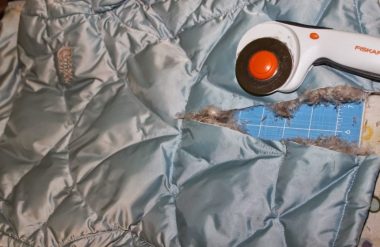Adaptive Clothing Fits the Needs of My Daughter With Rett Syndrome
A columnist learns to refashion jackets for her special-needs child

Dressing a child with special needs can be a huge challenge. The child might have sensory sensitivities, low muscle tone, or a feeding tube, which can create challenges for parents since there are limited clothes made for such needs. These parents can’t just walk into a store and purchase off the rack as easily as they could for a neurotypical child.
Target’s Cat & Jack is a fantastic line of special-needs clothing. It has shoes with zippers to make them easier to put on feet that need orthotics. It also has Halloween clothes for children in wheelchairs and who have sensory sensitivities. But till another reputable outdoor gear company makes jackets for people with special needs, I have to adapt and refashion jackets for my 13-year-old daughter, Cammy.
Cammy has Rett syndrome, which affects everything she does. She’s unable to dress herself, walk, talk, or even use her hands. She relies on others for everything. Cammy also has very low muscle tone, which makes dressing her a challenge.
When she got her wheelchair, I had difficulty putting jackets on her quickly and easily. At first, I put her jackets on backward — sliding her arms through and tucking the front side behind her. But that didn’t look right at all. Then I brainstormed with my mother-in-law, and together we figured out a way to cut the jacket so that it looked as if it were on correctly, even though it had been adapted.
Here’s how I did it, and how you can do it, too.
First, unzip the zipper and lay it flat. Using the tag inside the jacket as a guide, cut the jacket right down the middle of the back. Now, the jacket is in two pieces. Use Double Fold Bias Tape to sew up the slits you just cut. Sew on a few pieces of Velcro along the new seams so the back can close up. Keep the zipper closed in the front, slide the arms through, and Velcro the back shut.

Jacqueline uses a rotary cutter or scissors to cut the jacket in half. (Photo by Jackie Babiarz)

Cammy’s jacket slides on over the arms and uses Velcro in the back. (Photo by Jackie Babiarz)
The refashioned jacket makes getting her ready in the morning so much easier. When she is cold in school, for instance, her aide has an easier time getting the jacket on her. Thankfully, Cammy has many cousins who have passed on their old jackets, which I use as raw material. They let me make outerwear that makes Cammy feel more included while she stays warm.

Cammy in 2014, when her mother began to refashion her jackets. (Photo by Jackie Babiarz)
Note: Rett Syndrome News is strictly a news and information website about the disease. It does not provide medical advice, diagnosis, or treatment. This content is not intended to be a substitute for professional medical advice, diagnosis, or treatment. Always seek the advice of your physician or other qualified health provider with any questions you may have regarding a medical condition. Never disregard professional medical advice or delay in seeking it because of something you have read on this website. The opinions expressed in this column are not those of Rett Syndrome News or its parent company, Bionews, and are intended to spark discussion about issues pertaining to Rett syndrome.








Leave a comment
Fill in the required fields to post. Your email address will not be published.